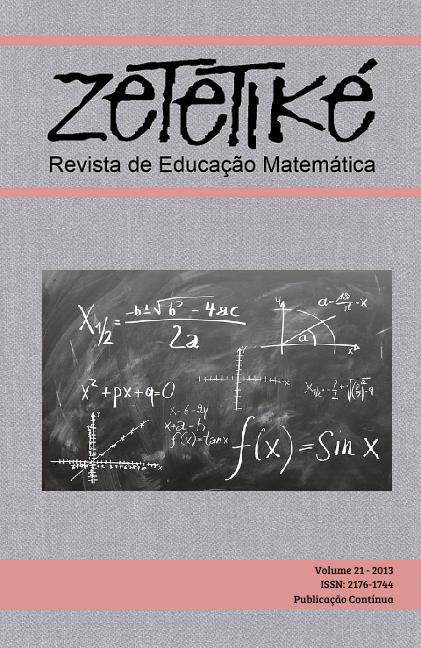Abstract
This investigation aims to analyze how students and professor conceive
aspects related to acquisition, construction and interpretation of senses or meanings,
produced or exposed while studying and teaching in an Analytic Geometry course
for Mathematics Undergraduate students at the State University of Feira de Santana -
BA. For this purpose, a research is carried out based on ethnographical practice,
considering the proposal and argument that an environment is constituted by a
multicultural cognitive universe or even by a micro-society, rich in the production of
meanings. Thus, the method of observation places the researcher in a estrangement
position, aiming at an impartial view. In this context, it is admitted that graphical
representations carry along psychological and sociological factors, perceptive,
cognitive and affective schemes, and also that social and cultural factors are directly
related to multiple interpretations concerning a geometrical, mathematical and
symbolical element.
References
ANDRÉ, M. E. D. A. Etnografia da prática escolar. Campinas, SP: Papirus, 1995.
ARCAVI, A. The Role of Visual Representations in the Learning of Mathematics. Educational Studies in Mathematics, Morelos, Mexico, v. 52, n. 3, p. 215-241, 2003.
BAKHTIN, M. M. Marxismo e filosofia da linguagem: problemas fundamentais do método sociológico na ciência da linguagem. 3. ed. São Paulo: Hucitec, 1986.
BARUFI, M. C. B. A construção/negociação de significados no curso universitário inicial de Cálculo Diferencial e Integral. 1999. 184 f. Tese (Doutorado em Educação) – Faculdade de Educação, USP, São Paulo, SP.
BKOUCHE, R.; LILLE, I. Sobre o ensino da Geometria. Boletim GEPEM – UFRJ, Seropédica, Rio de Janeiro, n. 14, p. 55-70, 1982.
DUBOIS, J. Dicionário de linguística. 8. ed. São Paulo: Cultrix, 2001.
DUVAL, R. Sémiosis et Penseé Humaine: Registres Sémiotiques et Apprentissages Intellectuels. Berna: Peter Lang, 1995. p.173-207.
ECO, U. As formas do conteúdo. Tradução de Pérola de Carvalho. São Paulo, SP: Perspectiva, 1974.
FAINGUELERNT, E. K. Educação Matemática: representação e construção em Geometria. Porto Alegre: Artes Médicas Sul, 1999.
FLORES, C. R. Registros de representação semiótica em matemática: história, epistemologia, aprendizagem. BOLEMA, Rio Claro, São Paulo, ano 19, n. 26, 2006.
GEERTZ, C. A interpretação das culturas. Rio de Janeiro: LTC, 1989.
GOULART, J. S. S. Desenhos e gráficos: Produção de significados pelos participantes de um curso de Geometria Analítica. 2008. 115f. Dissertação (Mestrado em Desenho Cultura e Interatividade) – Departamento de Letras e Artes, Universidade Estadual de Feira de Santana, Feira de Santana, Bahia.
LADRIÈRE, J. A articulação do sentido. São Paulo: E.P.U; EDUSP, 1977.
OTTE, M. Epistemologia matemática de um ponto de vista semiótico. Educação Matemática Pesquisa: Revista de Estudos Pós-Graduados em Educação Matemática – EDUC, Pontifícia Universidade Católica de São Paulo, São Paulo, v. 3, n. 2, p. 11-58, 2001.
PERUZOLLO, A. C. Elementos de semiótica da comunicação: quando aprender é fazer. Bauru, SP: EDUSC, 2004.
PEIRCE, C. S. Semiótica. 2. ed. São Paulo: Perspectiva, 1995.
PEIRCE, C. S. Semiótica e Filosofia. São Paulo: Cultrix; USP, 1972.
RADFORD, L. Introducción semiótica y educacción matemática. RELIME (Revista Latinoamericana de Investigacion em Matemática Educativa), México, v. 9, 2006. Número especial. Disponível em: http://redalyc.uaemex.mx/redalyc/src/inicio/ArtPdfRed.jsp?iCve=33509902&iCveNum=4372 Acesso em: 05 ago. 2007.
RADFORD, L. Semiótica cultural y cognición. In: REUNIÓN LATINOAMERICANA DE MATEMÁTICA, 22., 2004, México. Conferência Plenária. Disponível em: http://www.merc.laurentian.ca/NR/rdonlyres/808730CD-2FF4-45A3-AB1B-06BAFF87B51B/0/Tuxtla3.pdf. Acesso em: 4 fev. 2008.
SAUSSURE, F. Curso de Lingüística Geral. Tradução de Antônio Chelini, José Paulo Paes e Izidoro Blikstein. 27. ed. São Paulo: Cultrix, 2006.
STEINBERG, M. Os elementos não-verbais da conversação. 1. ed. São Paulo: Atual, 1988.
SOUZA, L. S. Introdução às teorias semióticas. Petrópolis, RJ: Vozes, 2006.
VYGOTSKI, L. S. A formação social da mente. São Paulo: Martins Fontes, 1984.

This work is licensed under a Creative Commons Attribution-NonCommercial-NoDerivatives 4.0 International License.
Copyright (c) 2014 Zetetiké: Revista de Educação Matemática

